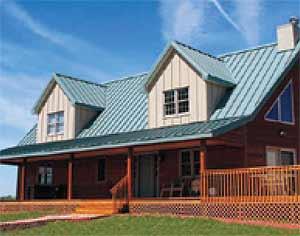Using Cool Roofs to Reduce Heat Islands
A high solar reflectance—or albedo—is the most important characteristic of a cool roof as it helps to reflect sunlight and heat away from a building, reducing roof temperatures. A high thermal emittance also plays a role, particularly in climates that are warm and sunny. Together, these properties help roofs to absorb less heat and stay up to 50–60°F (28–33°C) cooler than conventional materials during peak summer weather.1
Building owners and roofing contractors have used cool roofing products for more than 20 years on commercial, industrial, and residential buildings. They may be installed on low-slope roofs (such as the flat or gently sloping roofs typically found on commercial, industrial, and office buildings) or the steep-sloped roofs used in many residences and retail buildings.
Through the ENERGY STAR program, EPA and the Department of Energy (DOE) help consumers and other purchasers identify the most energy-efficient roofing products. Roofing materials with the ENERGY STAR label have met minimum solar reflectance and reliability criteria. Based on 2006 data from more than 150 ENERGY STAR partners, shipments of cool roof products have grown to represent more than 25 percent of these manufacturers' commercial roof products and roughly 10 percent of their residential roof products.
Benefits and Costs
Cool roofs provide a number of benefits beyond urban heat island mitigation, including:

- Reduced energy use: A cool roof transfers less heat to the building below, so the building stays cooler and uses less energy for air conditioning.
- Reduced air pollution and greenhouse gas emissions: By lowering energy use, cool roofs decrease the production of associated air pollution and greenhouse gas emissions.
- Improved human health and comfort: Cool roofs can reduce air temperatures inside buildings with and without air conditioning, helping to prevent heat-related illnesses and deaths.
Cool roofs deflect some desired heat gain during the winter. In general, though, cool roofs result in net energy savings, especially in areas where electricity prices are high.
Although costs will vary greatly depending on location and local circumstances, cool roof coatings on a low-slope roof might cost $0.75–$1.50 per square foot, while single-ply cool roof membrane costs vary from $1.50–$3.00 per square foot. The cost premium for cool roofs versus conventional roofing materials ranges from zero to 5 or 10 cents per square foot for most products, or from 10–20 cents for a built-up roof with a cool coating used in place of smooth asphalt or aluminum coating.2
A California study found that cool roofs provide an average yearly net savings of almost 50 cents per square foot. This number includes the price premium for cool roofing products and increased heating costs in the winter as well as summertime energy savings, savings from downsizing cooling equipment, and reduced labor and material costs over time due to the longer life of cool roofs compared with conventional roofs.
For More Information
More details are available in Chapter Four of EPA’s Reducing Urban Heat Islands: Compendium of Strategies, which covers the following topics:
- Cool roof properties that help to mitigate urban heat islands
- Types of cool roofing
- Benefits and costs of cool roofs
- Measurement and certification of cool roof products
- Installation and maintenance of cool roofs
- Tools and resources to further explore this technology
References
1. These temperature ranges are compiled from the following individual reports:
Konopacki, S., L. Gartland, H. Akbari, and I. Rainer. 1998. Demonstration of Energy Savings of Cool Roofs (PDF) (120 pp, 21.1MB). Paper LBNL-40673. Lawrence Berkeley National Laboratory.
Gartland, L. 1990. Cool Roof Energy Savings Evaluation for City of Tucson.
Miller, W.A., A. Desjarlais, D.S. Parker, and S. Kriner. 2004. Cool Metal Roofing Tested for Energy Efficiency and Sustainability. CIB World Building Congress, May 1-7, 2004. Toronto, Ontario.
Konopacki, S. and H. Akbari. 2001. Measured Energy Savings and Demand Reduction from a Reflective Roof Membrane on a Large Retail Store in Austin (PDF) (33 pp, 5.8MB). Paper LBNL-47149. Lawrence Berkeley National Laboratory.
2. Levinson, R., H. Akbari, S. Konopacki, and S. Bretz. 2002. Inclusion of Cool Roofs in Nonresidential Title 24 Prescriptive Requirements (PDF) (64 pp, 492K). Paper LBNL-50451. Lawrence Berkeley National Laboratory.
